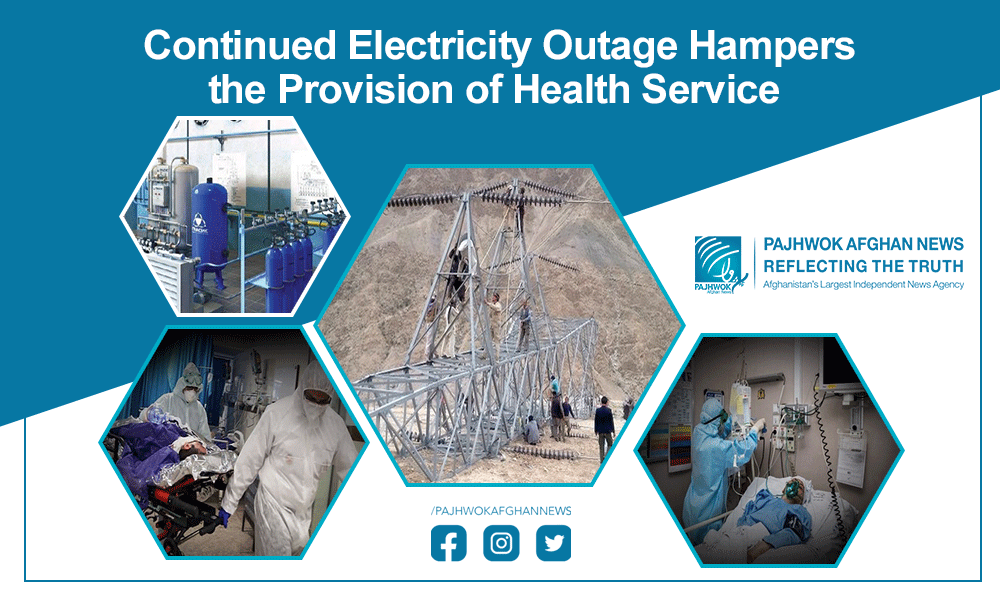KABUL (Pajhwok): Electricity outages due to destruction of power pylons have not only raised concerns among people and created issues in different sectors, but also crippled health services, which even lead to the death of Covid-19 patients.
Recently, the destruction of imported power pylons in different parts of the country has resulted in decreased supply of electricity.
According to reports, in the last three months, about 26 power pylons have been destroyed in Nangarhar, Kapisa, Parwan, Kabul and other provinces.
Kabul residents, including health officials, are complaining about power outages and call for an immediate solution to the issue.
Concerns of officials of private, state health sectors:
Dr. Eidwali Jan Mansoor, head of Mohammad Ali Jinnah Hospital, said electricity was vital during Covid-19 outbreak, as oxygen was the first important element in treating Covid patients.
“Producing oxygen without electricity is impossible, so electricity is directly linked to life in this pandemic situation, while Covid is worse than ever in Afghanistan,” Mansoor said.
He said when he asked the oxygen-producing companies to provide them with oxygen, their first excuse was lack of electricity and their excuse was right.
As a doctor, he urged all parties involved not to play with people’s lives by cutting off electricity and instead make serious efforts for sustainable power supply and this will be a historic service to the people of Afghanistan in such a difficult situation.”
Dr. Hashmatullah Faizi, head of the intensive care unit (ICU) at the Afghan-Japan hospital, told Pajhwok that the increase in power outages in recent months had created many problems in the delivery of health services.
He said: “The surge in power outages has reduced oxygen production, disrupted laboratory work and caused problems in many hospitals.”
He said that there were power generators in all public and private health centers which had solved the problem to some extent. “With the increase in power outages, generators are being used in hospitals, diagnostic centers, oxygen and pharmaceutical factories”.
He said: “We use generators in the Afghan-Japan hospital during power outages, and when the issue continues, we face a lot of problems because the power generators do not generate enough electricity.”
Dr. Mohammad Hashim, director of Wahaj Private Hospital and a representative of “Covid-19 test laboratories”, also expressed concern over the continuous power blackout after the destruction of power pylons, saying the sabotage also hampered the delivery of services in health facilities.
He confirmed that power outages in recent months had adversely affected the functioning of private and public health facilities.
Referring to health services in the face of power outages, he said: “Some patients are on ventilators, and others are on different machines, if the power is cut, it is very dangerous and harmful and it leads to the death of some patients whose oxygen is repeatedly cut off.”
Dr. Sayed Khalid Rashid, director of Al-Hayat hospital, confirmed the problem and said that the continuous power outages had created many problems in hospitals, diagnostic centers and oxygen production plants.
Rashid said health facilities needed 24 hours electricity and when the outage happened, health centers had to use generators which led to higher costs and even forced some hospitals to suspend services.
He attributed the deaths of many patients to power outages in hospitals, saying: “Sometimes more than 10 times the electricity is cut off which delays all systems of the hospital.”
“Most of the medical equipment take time to turn on, we are witnessing some Covid-patients who were connected to the artificial respiratory system become silent during the power outage, which made the patients’ condition worse and, in some cases, even the patient dies.”
Khalilullah Waziri, head of lab information at the “City Baheer” laboratory in Mazar-i-Sharif, said there was power outage at health facilities, especially at the Covid-19 diagnostic center.
He said: “Although we use power generators in the absence of power supply, it hampers our work. Unfortunately, some public and private hospital laboratories are less likely to work without electricity.”
He said when power was cut off, some machines could not get the required power from the generators, which was very dangerous for patients connected to the machine.
Recent outages of electricity reduced oxygen production:
Najibullah Sediqi, director of an oxygen-producing factory named “Wahdat”, criticized the continued outage of power, saying: “Oxygen production stops for half an hour after each electricity outage, as it takes at least half an hour for the oxygen production plant to resume work.”
According to him, his factory has the capacity to produce 550 balloons of 42-kg each oxygen in 24 hours, but when the power is cut off, the production rate decreases”.
Sediqi called on the government to address the problem of prolonged power outages caused by power pylons destruction.
According to reports, due to a power pylon destruction in Herat province, the electricity from Iran was cut off to the province, bringing to a halt all type of productions, including oxygen production.
Ministry of Public Health on electricity outage:
Usman Tahiri, deputy spokesman for MoPH said: “Unfortunately, the power outage has created problems for all people including the health sector.
He added that power generators were used in all health centers and hospitals in absence of electricity, which was not enough and created problems in come centers.
He said efforts were being made to keep the generators active to supply power to the affected areas.
Doctors, hospitals and the MoPH were not be blame for the power outage and they should not be accountable or punish in this regard. The issue should be seriously addressed in collaboration with security agencies.
Pylons’ destruction must be stopped: public
Ahmad Khalild, a resident of ChaharQala area of Kabul, said: “For the past two months, there has been no electricity for many days, and all people, especially patients, are facing a host of problems.”
He said one of his relatives lost life due to lack of electricity because his ventilator turned off.
Power utility: efforts underway to stop pylons’ destruction
Mohammad Hashim Sangar Nizai, spokesman for Da Afghanistan BreshnaShirkat, called the destruction of power pylons was the work of the enemies of light.
Meanwhile, four people have been arrested in connection with destruction of power pylons in Parwan last week.
Parwan Police chief Brig. Gen. Abdul Rauf said they had arrested four people in an operation in the Salang district who were involved in destroying electricity pylons and planting landmines to target military vehicles.
According to him, the leader of the three-member group is Mamati’s brother who was the first person to destroy power pylons in Salang. He said the detainees were being interrogated.
The recent destruction of power pylons comes at a time when domestic power generation is currently 206 megawatts, 380 megawatts of electricity is imported form Uzbekistan, in addition, Afghanistan needs 550 megawatts more electricity.
According to the power utility, about 35 percent of the country’s population has currently access to electricity, while about 75 percent of Afghanistan’s electricity is imported.
Sa/ma
 “This Investigative Report was produced with the financial support of the European Union. Its contents are the sole responsibility of Pajhwok and do not necessarily reflect the views of the European Union.”
“This Investigative Report was produced with the financial support of the European Union. Its contents are the sole responsibility of Pajhwok and do not necessarily reflect the views of the European Union.”








GET IN TOUCH
NEWSLETTER
SUGGEST A STORY
PAJHWOK MOBILE APP